Turmeric Leaves Patholi
A plant based Mangalorean/Goan snack 'Turmeric Leaves Patholi' celebrates the fresh turmeric leaves of summer. These fragrant steamed parcels are made with ground rice with an aromatic filling of jaggery, coconut and cardamom. Served as breakfast, snack or afternoon tea.
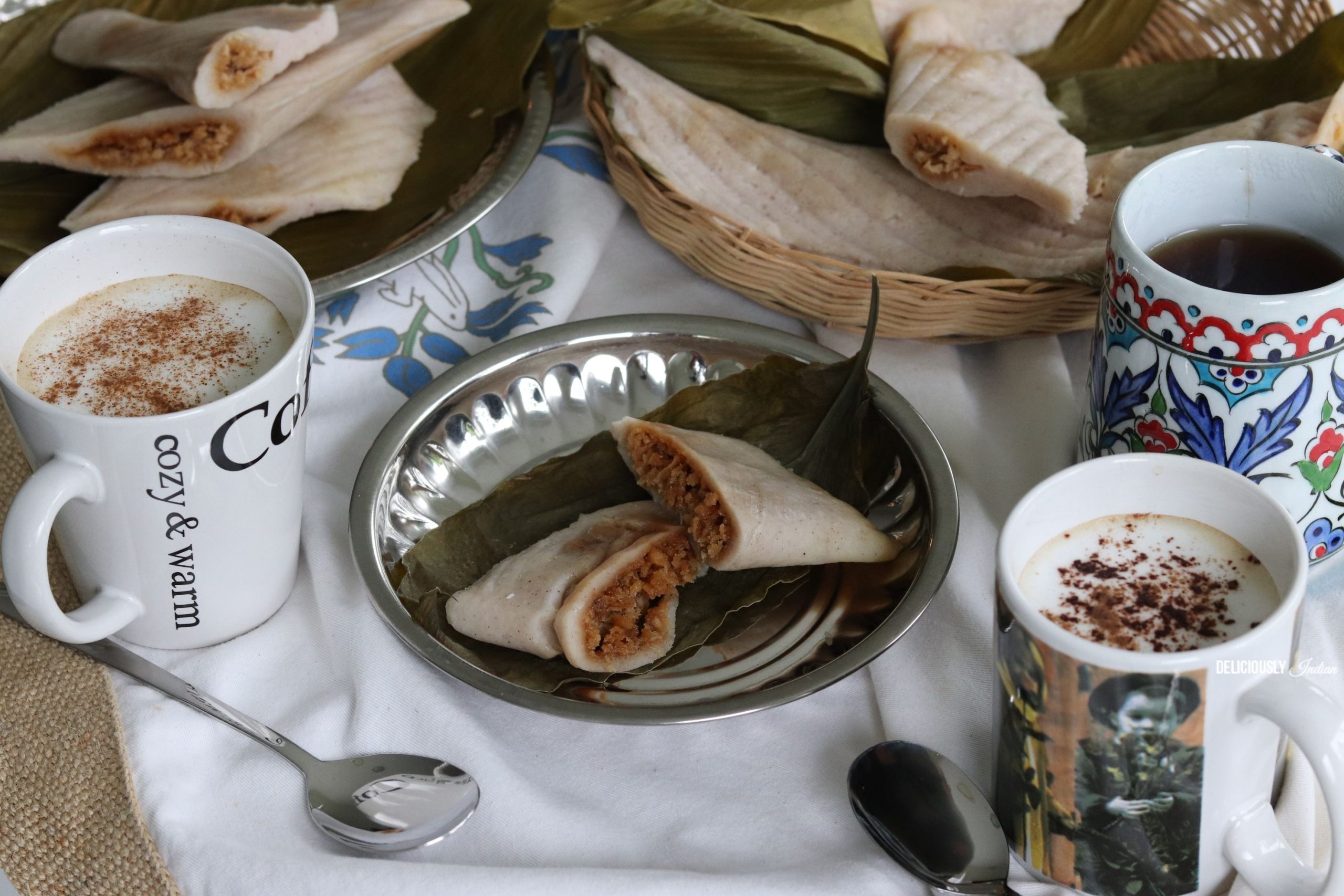
Looking for a recipe to make the most of your turmeric leaves this summer? Try these 'Turmeric Leaves Patholi'! You must hurry as the leaves will last only for another month or so!
A fantastic example of a traditional Mangalorean/Goan style cuisine, is this plant based steamed aromatic snack called ‘patholi’. They are made with freshly ground rice paste, with a fragrant coconut, jaggery and ground cardamom filling. Wrapped and steamed with home grown lush turmeric leaves, these patholies fill the house with floral aromatics, and celebrate flavours reminiscent of my childhood. Preparing this patholi takes me on an exciting voyage to ‘Ell-dun’, my beautiful coastal home across the oceans!
These patholies make a stunning Mangalorean home style breakfast, snack or afternoon tea! Serve them with tea, coffee, filter coffee, masala tea or Masala Coffee!
what is a patholi?
A 'Patholi' is a traditional Mangalorean rice flat bread/snack, with either a savoury or a sweet filling made with simple ingredients but packed with delicious flavours!
This is a recipe for 'Patholies'/sweet dumplings (flat rice bread parcels with a coconut and jaggery filling) that really makes the most of turmeric leaves! These patholies are nothing but ground rice flattened on fresh turmeric leaves, with a filling made up of jaggery, coconut and cardamom powder. They are steamed in an idli steamer until they are infused with incredible turmeric flavour, that fills not just the kitchen but the entire house. Serve them straight from the steamer for the best 'patholi' eating experience with a side of plain tea, coffee or Masala Coffee or Masala tea. If you have any leftovers, share them with your extended family or with your fellow Hungry Mangies as I did!
Patholies are a Mangalorean favourite and many Mangaloreans in Sydney have turmeric leaves growing in pots or in the soil in their backyard gardens, with the sole purpose of making these patholies.
I have lived in Australia for decades, however, I have never owned a turmeric pot. Thanks to Rekha, my neighbour, who took me to a home nursery in Lane Cove, where I bought my first index finger size turmeric plant. I planted this baby plant sometime in autumn (March/April) last year and the plant stayed dormant till November. I was looking forward to making these patholies and eagerly awaiting for the leaves to sprout.
Bingo! by the last week of November I could see a couple of small leaves sprouting. I was overjoyed that my dreams of making patholies with home grown turmeric leaves were so close to fruition. By the last week of December, I had at least 12 leaves, some small, some medium and some large.
I set out to make 'patholies' for the first time in three decades with my own home grown turmeric leaves!
These patholies are a nostalgic treat from my childhood! My mother Stella, had an unique interest in cooking and she would cook delicious food with the simplest of ingredients, mostly from our home grown vegetable patch. I cannot recall that we had a turmeric bush at home or whether she would buy these leaves from the vegetable market (Wednesday Saanth). Either way, she had the freshest leaves that sent the aroma all around the house when I came back from school.
Memories so fresh stir up each time I cook something my mother taught me!! She would be clapping in heaven knowing her daughter is still enjoying these delicious 'turmeric leaves patholies'!
Creating this aroma in my home so far away from my childhood home, connects me to my mum wholly and solely!
Turmeric lives for more than two years, therefore it does not need to be replanted every year. The plant grows to about 1m tall and has beautiful white flower spikes, if the clumps are left undisturbed for a year.
Turmeric is a perennial herb and will be dormant during the winter months (June-August in Australia) when the leaves turn yellow, look sad and die. The rhizomes that are covered in soil will continue to live, however, they will need to be watered less frequently during the winter months. In Australia, the leaves will sprout from end November and the leaves can be harvested from mid-December till February.
patholi making VIDEO
Spreading the paste on the turmeric leaf
ingredients in a patholi
There's not many ingredients in the rice paste (see photo below) nor in the filling itself (see below).
Once you follow my instructions and see the quick video, this patholi is very straightforward to make. You will await the sprouting of turmeric leaves every summer once you get a taste of these aromatic patholies!
Four quick steps to follow:
- First - soak the rice and make the paste. The secret is to get the paste to the right consistency. Once this is done, you are half way through!
- Second - spread the paste on to fresh turmeric leaves.
- Third - Combine the filling ingredients in the last minute, as the jaggery tends to get runny very quickly when it comes in contact with coconut. Add the coconut and jaggery filling in the centre of the leaves either lengthwise or breadthwise.
- Last - steam in an idli steamer till cooked. Cook in batches depending on the size of the steamer.
making the patholi paste
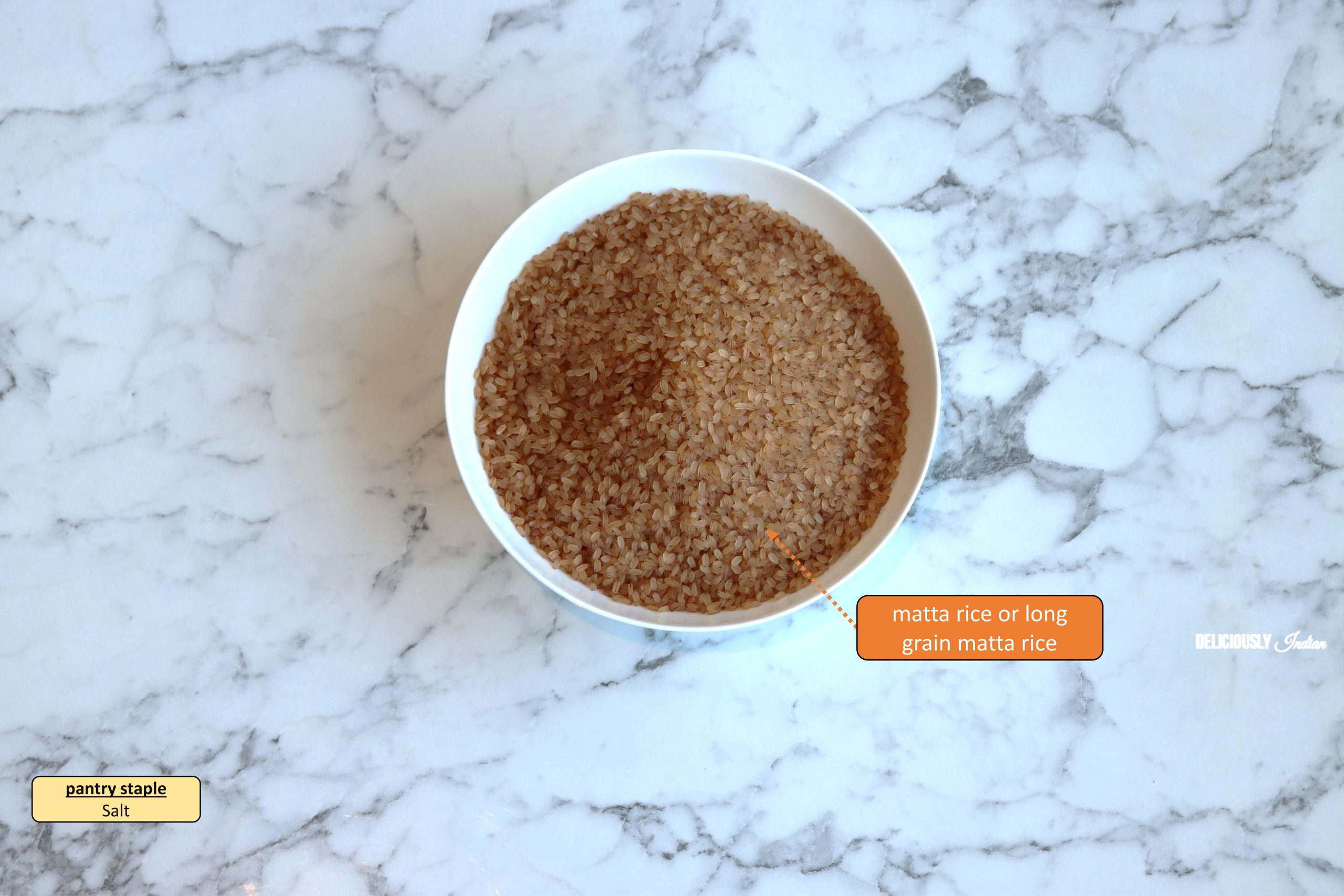
- Matta rice or long grain matta rice - A type of parboiled rice (do not mistake it for brown rice) with a robust and distinctly earthy flavour best suited for this recipe. This rice is fairly accessible in many Indian supermarkets. If you are unable to buy it at your local Indian supermarket, find at Udaya Supermart in Wentworthville or Liverpool. I buy the '24 Carat" "Matta Rice" sold in 1kg packets. Important: Please look for Matta Rice or Long Grain Matta Rice.
- Matta rice can be used to make delicious 'Mutlin/Mutlim/Pundi'.
making the patholi filling
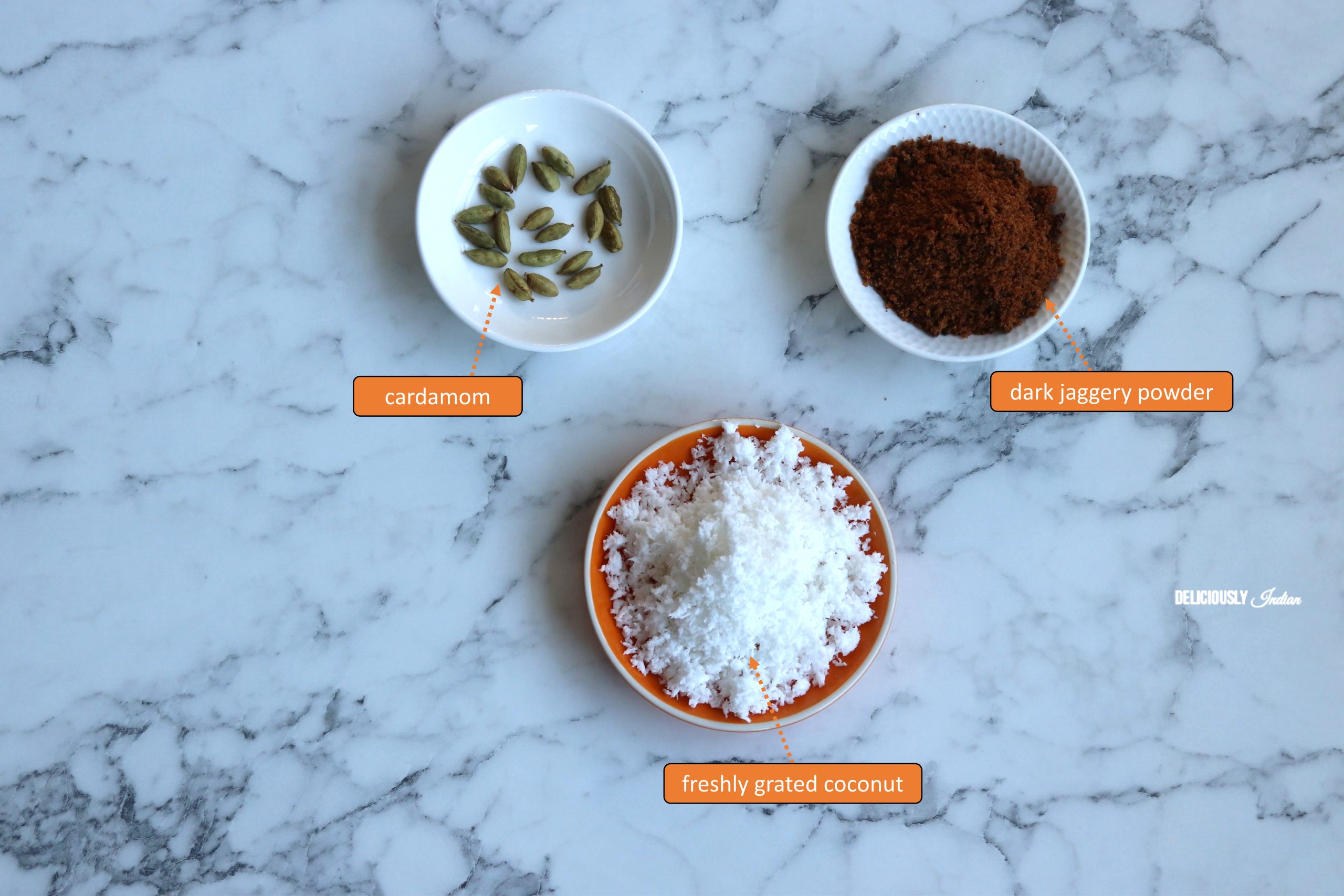
- Green cardamom powder - Added for its intense and slightly sweet flavour. The most flavour comes from the freshly powdered seeds of the green pods. Do not add the whole pods please! Peel the pods, powder them in a pestle and mortar before adding to your desserts or snacks. The pods are fairly accessible in many Indian supermarkets. For all the Sydneysiders, if you are unable to buy at your local Indian supermarket, find at Udaya Supermart in Wentworthville or Liverpool.
-
- Alternative: If you could not be bothered to make the powder yourself, you can buy the powder bottled/packets either in many supermarkets or in many Indian supermarkets - sold as 'Ground Cardamom'.
- Dark jaggery powder or light jaggery powder ( 'Palm Sugar' 'Gur' or 'Gaud') - A healthier sugar, as it has a lower sucrose content than white sugar. Added for the earthy sweetness in many Indian desserts and sweets. I buy the 'Aithra' brand "Dark Jaggery Powder" sold in 500g packets. If you are unable to buy it at your local Indian supermarket, find at Udaya Supermart in Wentworthville or Liverpool.
- How to store remaining jaggery?: Cover in a paper towel and place in airtight container with the bag at room temperature. Can last up to one year, if not exposed to moisture.
- Freshly grated coconut - Brings the whole snack together. Jaggery and freshly grated coconut are a match made in heaven. Added for texture and a gorgeous tropical flavour. Freshly grated coconut is a rare treat in Sydney, but is not easily accessible close to home. I buy whole coconut from my local supermarket and grate it (hard yards really!!). Often the flesh is not the freshest, so I use an alternative to save time and energy.
- Alternative: There are many brands sold in the freezer section of your local Indian supermarket either shredded or grated. My favourite brand is 'Kozhikoden's' Fresh Frozen Grated Coconut sold in 340g packs. The flesh is fresh, soft, moist and sweet. Use any brand, if this brand is not available.
FRESH TURMERIC LEAVES
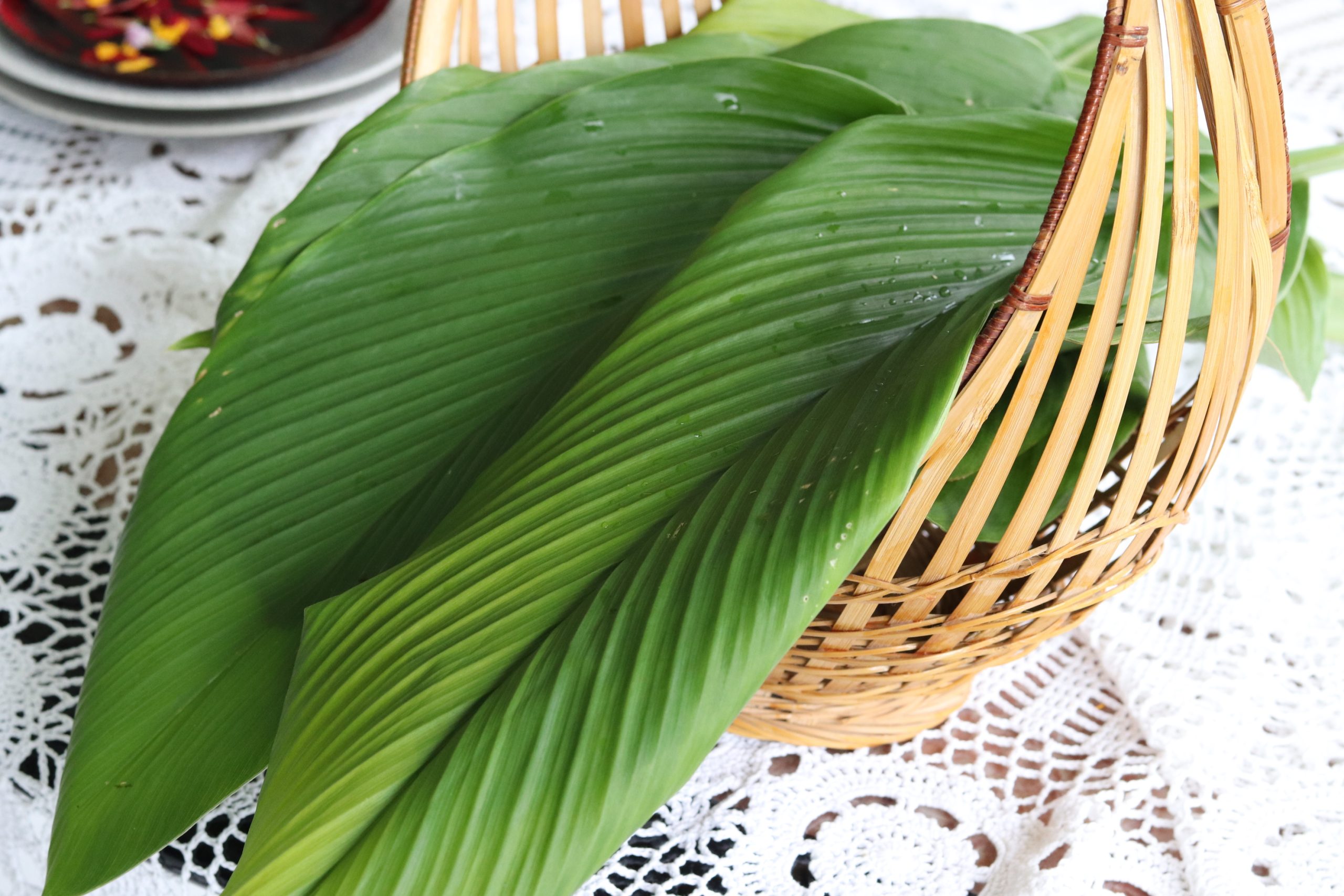
Turmeric leaves are also known as 'Haldi Leaves" or 'Manjal Leaves'
Ooops! oops! ooops! Please don't skip this!!
Patholies cannot be done without 'turmeric leaves'. Please have your leaves ready before you start cooking. If you have friends who are happy to share the leaves with you, please grab the leaves from them before you soak up the rice.
On the other hand, if you have turmeric in a pot or your backyard garden, you may remove the leaves in the last minute when you are just ready to spread the paste on to the leaves. This way, you are very sure that the leaves are fresh and impart that beautiful flavour into your dish!
Turmeric aka as Haldi in India (Curcuma Longa) is a part of the ginger family and is a native to Asia, specifically India.
It is a rhizome; a horizontal stem of a plant that grows underground. Did you know that turmeric is the oldest natural food dye in the world?
Turmeric powder is extensively used as a spice and seasoning in South Asian and Middle Eastern cooking especially in Indian, Persian and Thai dishes. It has an earthy taste, slightly bitter not too dissimilar from saffron and for this reason it is often used as an alternative to the far more expensive spice.
Apart from being used as a spice, turmeric is also used as a medicine and even in religious ceremonies. it's use dates back 4000 years ago in Ayurveda medicine, where it was used as an antiseptic to reduce symptoms colds, jaundice and intestinal worms.
I have distinct memories of being treated for my common colds by my mum, who used to light a piece of dried turmeric and the smoke was inhaled. Funnily, the treatment used to control the common colds. Further, ground turmeric was also used as an antiseptic externally to heal common cuts or abrasions.
Apart from turmeric, in regions where turmeric is freely grown, even the leaves are commonly used in curries, soups and chutneys.
Turmeric Leaves Flavour Profile??
Fresh turmeric leaves have a neutral aroma however, when they are cooked, they impart a floral, gingery and pungent flavour with notes of mint and grass.
In Indian, Indonesian and Thai cuisines, they are used as a wrapper for steamed dishes for this very distinct scent.
In Mangaloren and Goan homes 'Patholi' is a featured dish/snack/sweet dumpling. It is a famous flat bread with a filling (sweet or savoury) which is very popular when the turmeric leaves are in season. These flat bread parcels are made up of blended rice paste which is spread in a thin layer on fresh turmeric leaves, with a filling of freshly grated coconut, jaggery and ground cardamom. These parcels are then steamed and when the heat intensifies, the flavour of the leaves imparts to the dish. Whenever I make this dish, my house is filled with this delicious aroma, and it walks me to my mother's kitchen! Oh! I have just revealed my nostalgic secret!!
To get this distinct flavour, the leaves must be fresh and not dried. It is always good to remember that only the fresh leaves will release this gingery flavour to a dish, when steamed.
STEP-BY-STEP INSTRUCTIONS
This flat sweet rice bread/snack, some feel, is laborious to make however, as I had seen my mother preparing them during my school days, they are second nature to me. Many are already familiar with making these childhood home treats as you may have learnt from your mums or mothers-in-law or friends. Follow my instructions, and if you still have difficulty, either with blending the rice, making the filling or spreading the paste on to the leaf, please don't hesitate to get in touch with me. I would love to hear from you! I would not even mind tasting your creations as I love these patholies any day!!
Wash rice well and drain. Cover with water and soak for 4 hours

Drain rice completely. Place in a blender or similar appliance. Add salt and just enough water. Blend to a thick paste. Blend in batches if you have a small blender!
I use my 'Breville' heavy duty blender. I add approx. 350mL water per batch. Use this as a guide only, as blenders vary remarkably!
Start this recipe on the earlier day to save time.
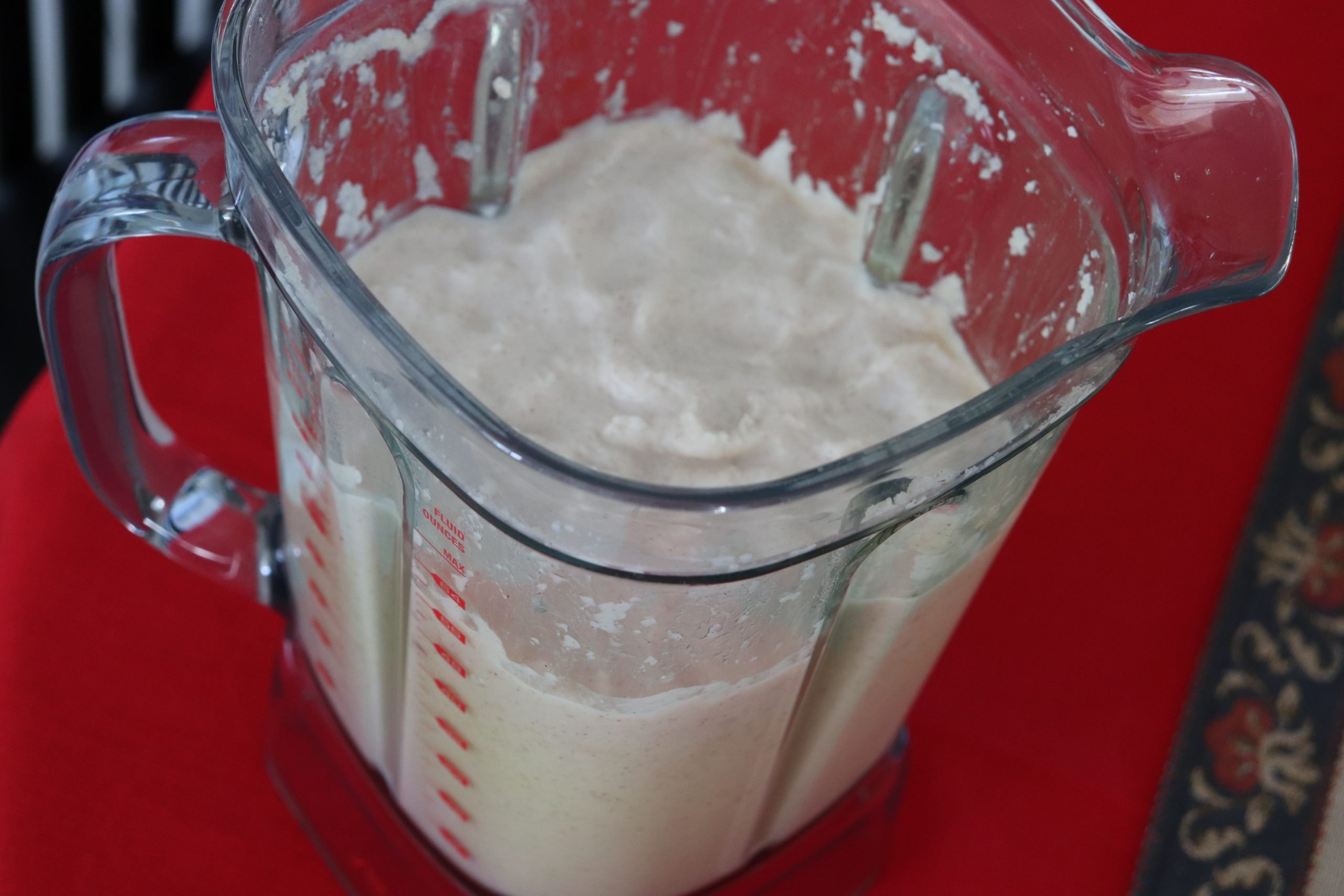
Blended paste. You get the idea! the paste has to be fairly thick. Runny paste will not stick to the leaf!
You can make this paste and place it in the fridge on the earlier day
Bring to room temperature before you start making the patholies

Wash the turmeric leaves and pat dry well with kitchen towel.
I had 15-18 very large leaves and they were 43cm long x 16cm wide. If you have smaller leaves, you will require more leaves for this amount of paste
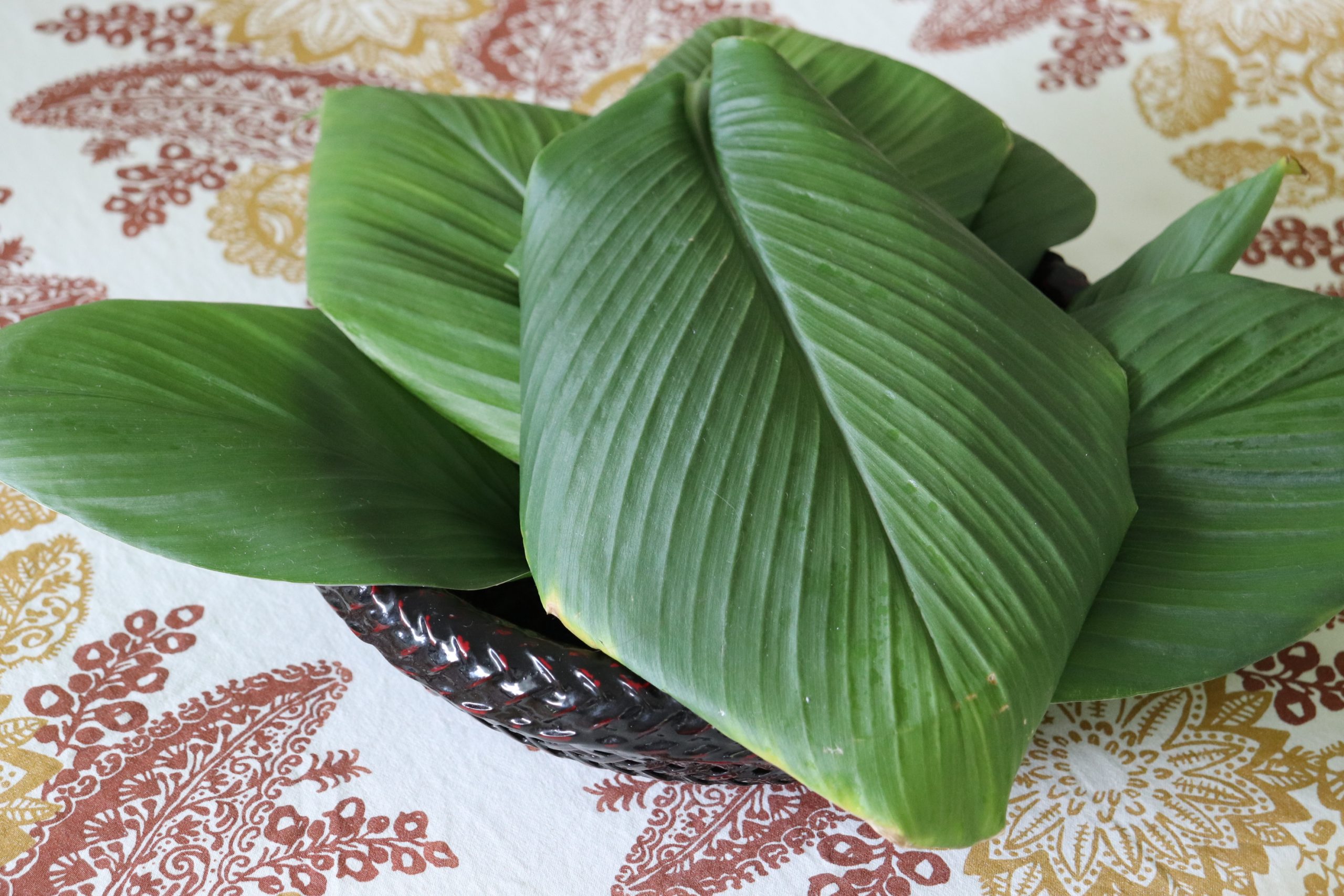
Spread approximately a golf size or tennis ball size (depending upon the size of the leaf) of paste over a leaf. Watch video above if in doubt!

To make the filling:
Combine the coconut, jaggery powder and the ground cardamom until you see no lumps

Place 2 tbsp. filling into the centre of the leaf either lengthwise or breadthwise

Leaf folded in half lengthwise. Seal the edges by pressing with your finger (watch video above, if in doubt)
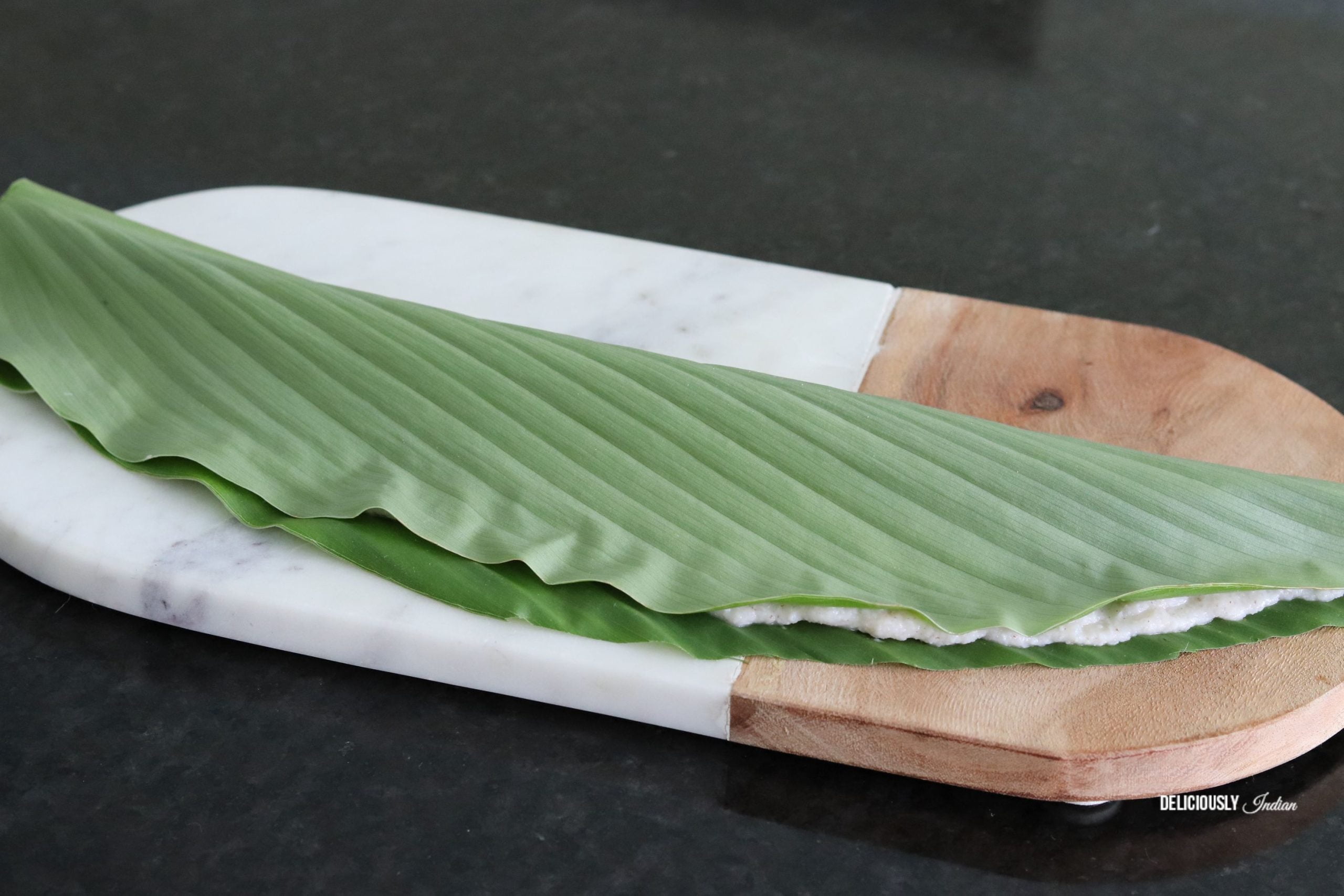
Filling placed breadthwise

Leaf folded in half breadthwise
The decision to place the filling either lengthwise or breadthwise is yours, depending the size of your idli steamer

Repeat the above two steps till all rice paste and the coconut jaggery mixture is exhausted!!
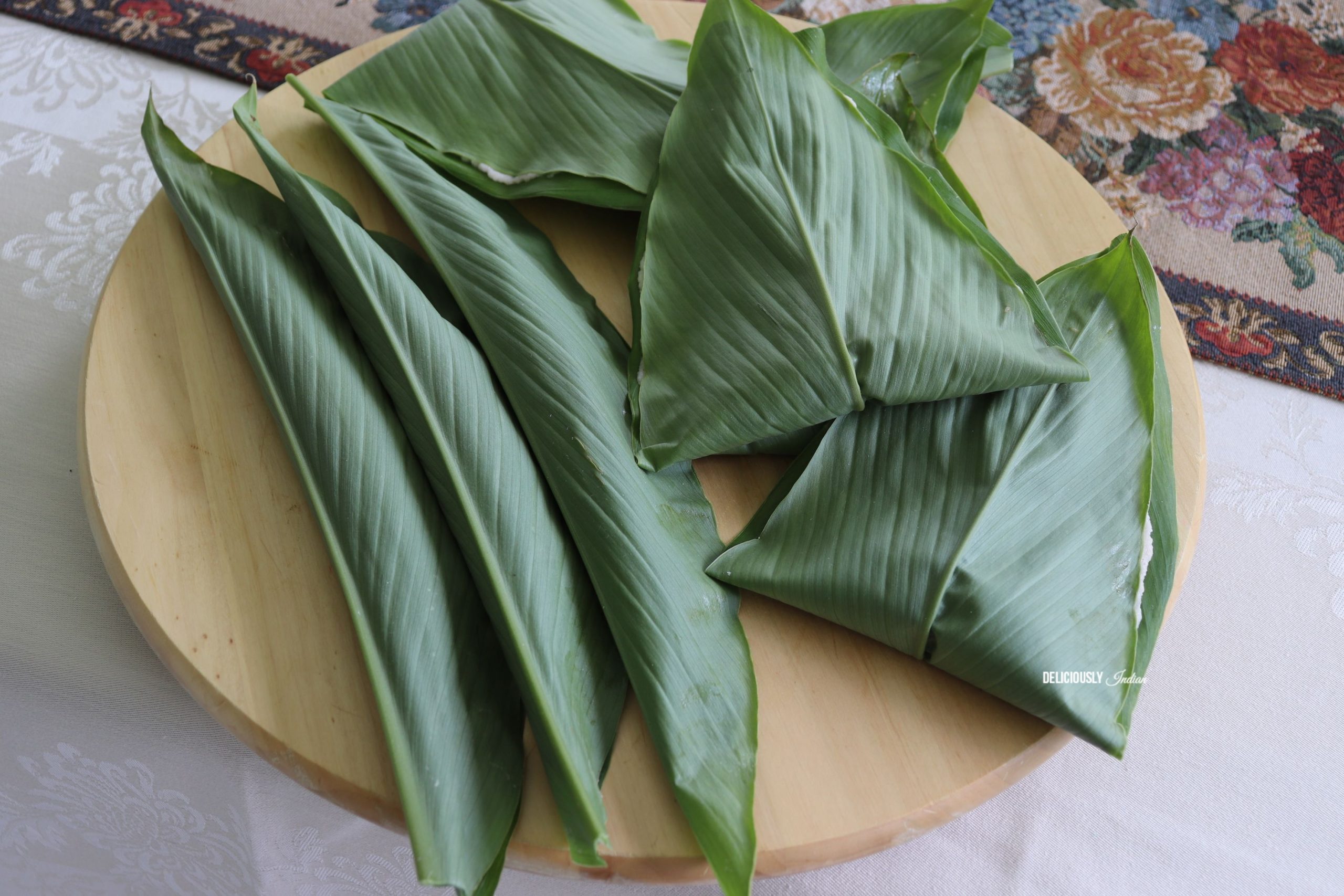
Add 3 litres water to an idli steamer (image on the right) and place on medium heat. Bring to a rolling boil

When the water comes to a rolling boil, using a heat proof glove, gently place the perforated lid into the slot in the steamer (as shown in the image)
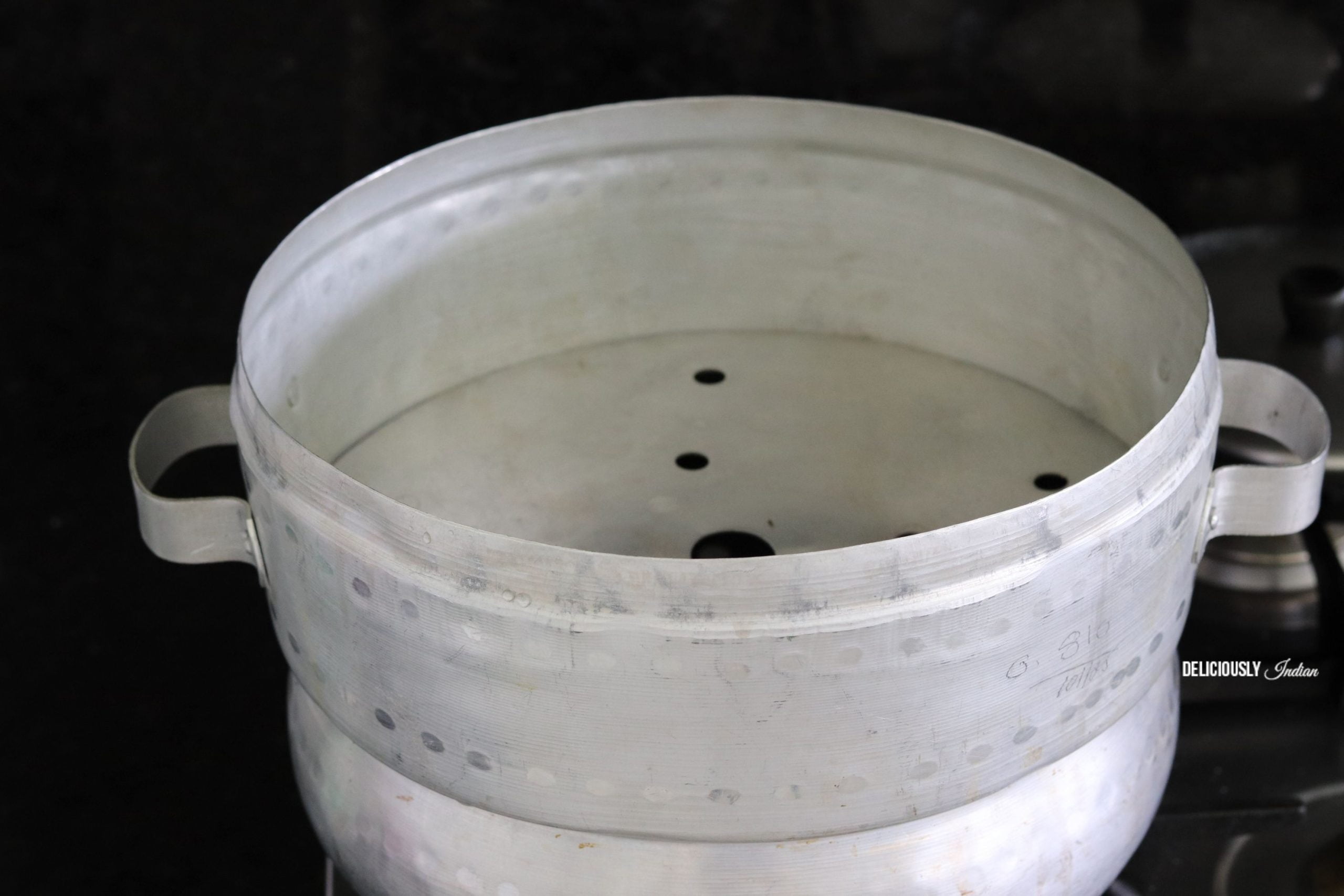
Stack all the prepared patholies directly on the perforated lid
Steam in batches if you have a small steamer!
Close lid and steam for 20 minutes for small leaves and 30 minutes for large leaves
If you have a combination of small and large leaves, then steam for 30 minutes to ensure all the patholies are uniformly cooked!
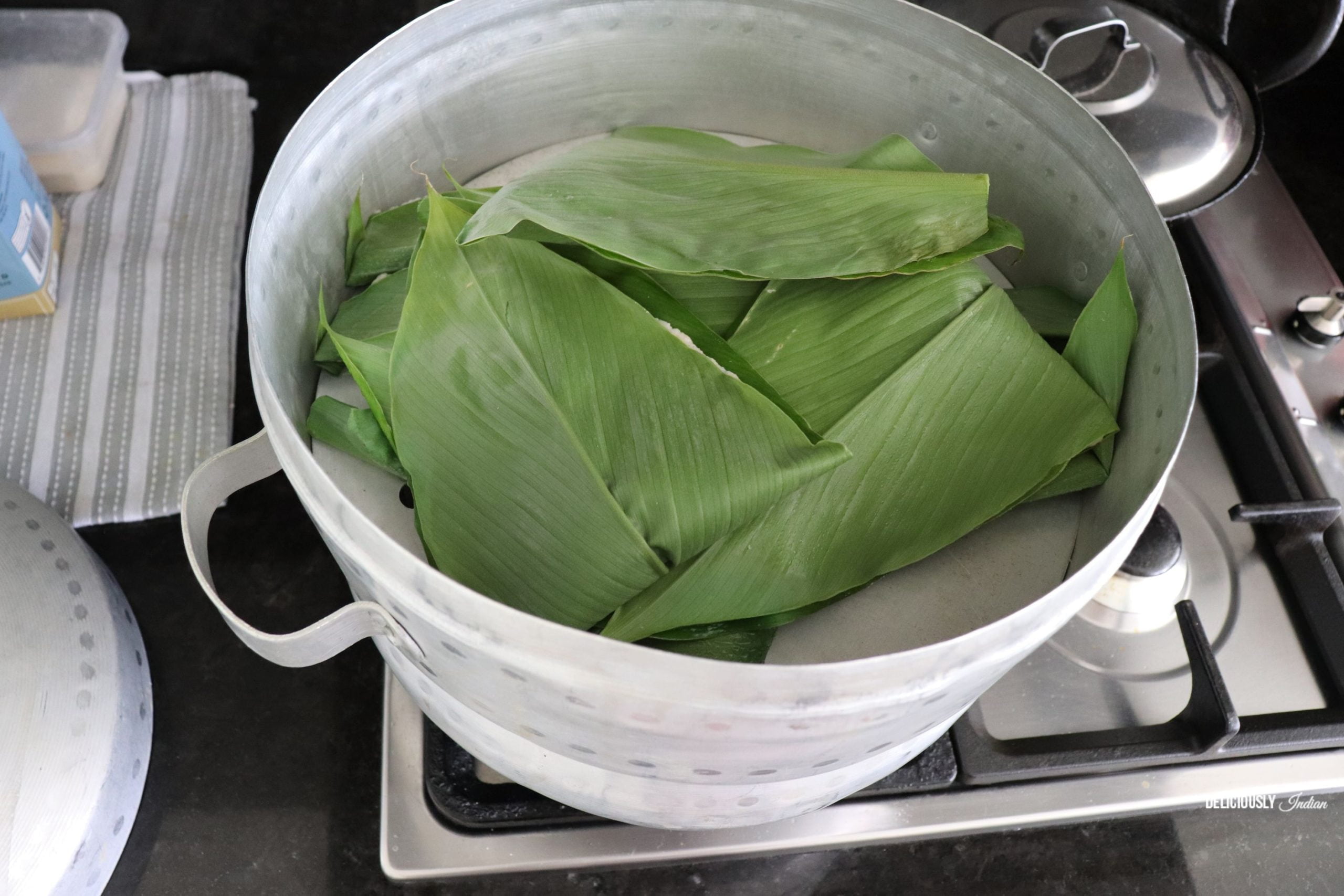
Freshly steamed patholies! Delightfully aromatic, Deliciously Indian, Deliciously Mangalorean!!
The leaves will impart their floral gingery scent to the patholi, when the heat is intensified during steaming
Steamed leaves lose their dark green colour during cooking!
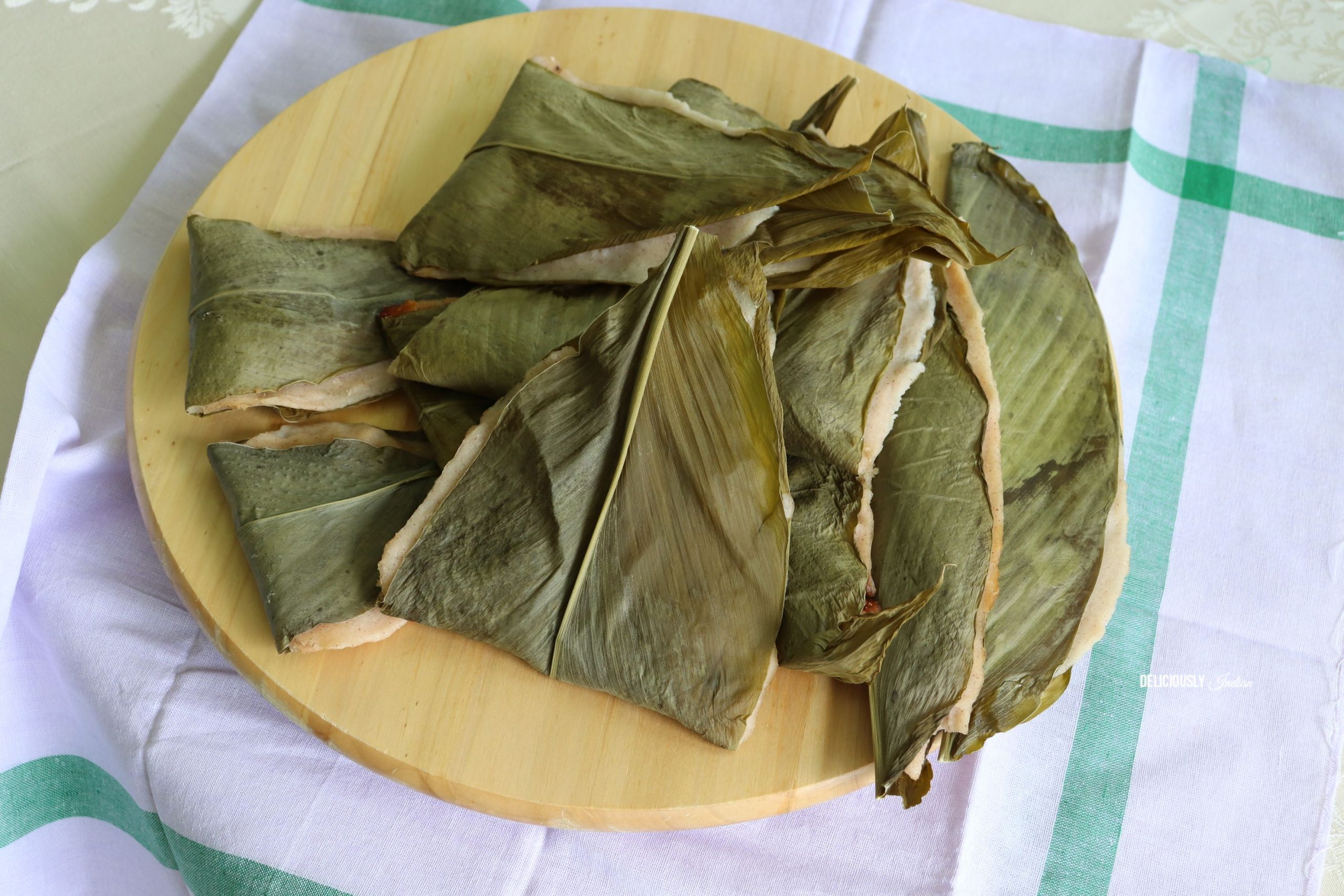
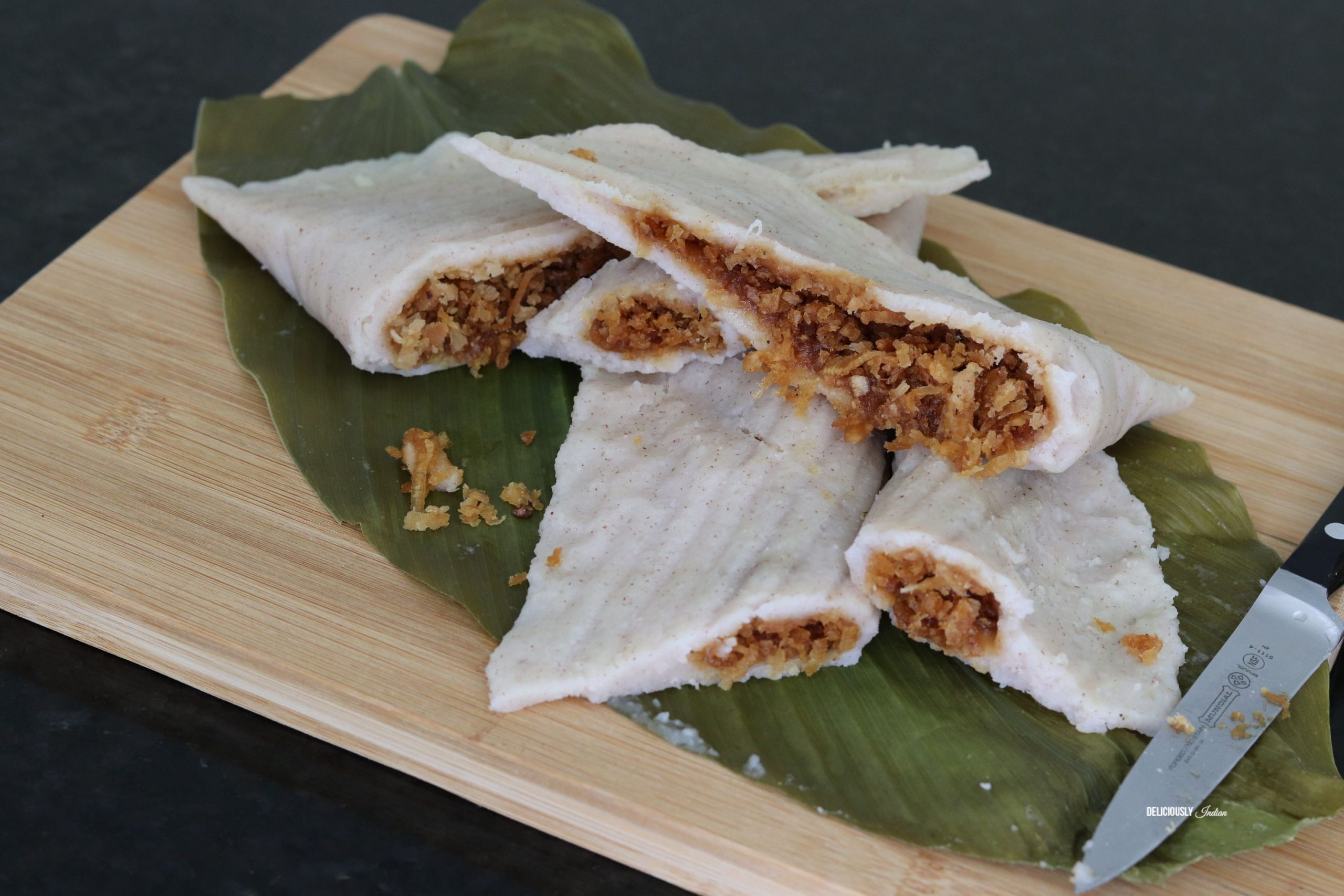
Plated aromatic patholies! so yumm! Love the pattern on the patholi! Gobble gobble!!
serving suggestions
- Remove the leaves (leaves are not to be eaten) and serve them hot on their own, for breakfast with coffee or tea.
- Serve with filter coffee or Masala Coffee as an all day snack.
- Serve them as a light lunch option.
- Invite friends for a games afternoon and serve them for afternoon tea.
how to store patholies?
Patholies are very popular around our house and usually do not make the second round. Should you have any leftovers, place them in an airtight container with their wrapped leaves and store in the fridge for up to 4 days.
To reheat, remove as many as you want and heat in the microwave with the wrapped leaves, until heated through (approx. 45 seconds to a minute). Remove the leaves and enjoy! Do not overheat patholies as they tend to go stiff!

Turmeric Leaves Patholi
Ingredients
Ingredients for the patholi
- 850 g matta rice or long grain matta rice
- 4½ tsp. salt or to taste (approx. 20g)
Ingredients for the filling
- 2 cups 250g freshly grated coconut or fresh frozen grated coconut defrosted
- 1½ cup 210g dark jaggery powder or any jaggery powder or to taste
- Seeds of 20 green cardamoms powdered 1½ tsp. powder
Instructions
- Wash rice in cold water and drain. Cover rice with cold water and soak for 3-4 hours. Soaking rice makes it easier to blend.
- Wash the turmeric leaves well. Wipe them thoroughly and set aside.
- Drain the soaked rice completely.
- Blend rice in 3 batches to a smooth consistency paste. Add all the salt to the first batch. You will need just enough water to turn the blades. In my Breville heavy duty blender, I add 350mL – 375mL water for each batch. The paste looks like the paste in the image. We want a spreadable paste (not runny) as we are going to spread this paste on to turmeric leaves. (SEE NOTES 1 and 2). Remove the ground paste on to a large bowl. Repeat the same step for the remaining batches until all rice is blended. Add all the ground batches to the same bowl.
- Combine all the ground paste to redistribute the salt. Season, if required. Now you are ready to make the patholies.
- The amount of paste to be used on each leaf depends on the size of the leaves. The smaller leaves require lesser paste, and the large leaves require more paste. I had very large leaves (43cm long x 16cm wide approx.) and I needed about the size of a tennis ball for each leaf.
- Place a leaf on a cutting board or a steady clean surface. Wet your hand slightly and grab enough paste (size of a golf ball or tennis ball depending on the size of the leaf) and place on the stalk end of the leaf. Using your fingers spread the paste till you get to the top of the leaf leaving 1 cm border all around the leaf for spillage. (See video here)
- Place about 2 tbsp. filling in the centre of the leaf (either lengthwise or breadthwise). Fold the leaf in half and press the edges to seal the filling.
- Add sufficient water into your idli steamer (thondor) and place on medium heat. I added 3 litres water as I have a medium size steamer. Bring the water to a rolling boil. Using heat proof gloves, gently stack the prepared patholies on to the steamer plate. Close lid and steam in batches if they do not fit in one batch, for 20 minutes for small leaves and 30 minutes for large leaves. If you have more than one batch to steam, check the steamer after the first batch and top up with more water, if required.
Method for the filling
- Peel the cardamoms and place all the seeds in a pestle and mortar. Powder.
- In a bowl, combine all ingredients together till well combined and the mixture is lump free.
Notes
- I have a heavy-duty blender (Breville) in which I blend my rice. The heavy-duty blenders use more water compared to Indian blenders, in order for the blades to rotate well. My instruction for water usage in Step 4 should be used as a guide only. Use discretion and instructions of your blender to blend the soaked rice.
If your paste has excess moisture, then place the paste in a microwave proof dish or bowl. Cover and microwave for 1 minute. Remove and stir the paste. Check if you can make a ball without the paste sticking to your hand. If so, then your paste is ready to roll into balls. - On the other hand, if your paste is still wet, then cover and return dish/bowl to the microwave, and microwave for another minute. Remove and stir. Test the paste to see if you can make a small ball without the paste sticking to your hand. If you cannot mould into a ball, repeat microwaving, for 1 or 2 minutes, with one - minute intervals, until your paste is dry enough. Ensure that your paste is not too dry, as you will not be able to spread the paste on to the leaves.
Please note, you do not need to make the balls, however, you need the dough dry enough so you can spread it on the leaves. Making the balls is a test to check if the dough is dry enough! - If you do not have freshly grated coconut, you may use good quality frozen grated or shredded coconut. Defrost the coconut completely as per the instructions on the packet before you start preparing the filling.


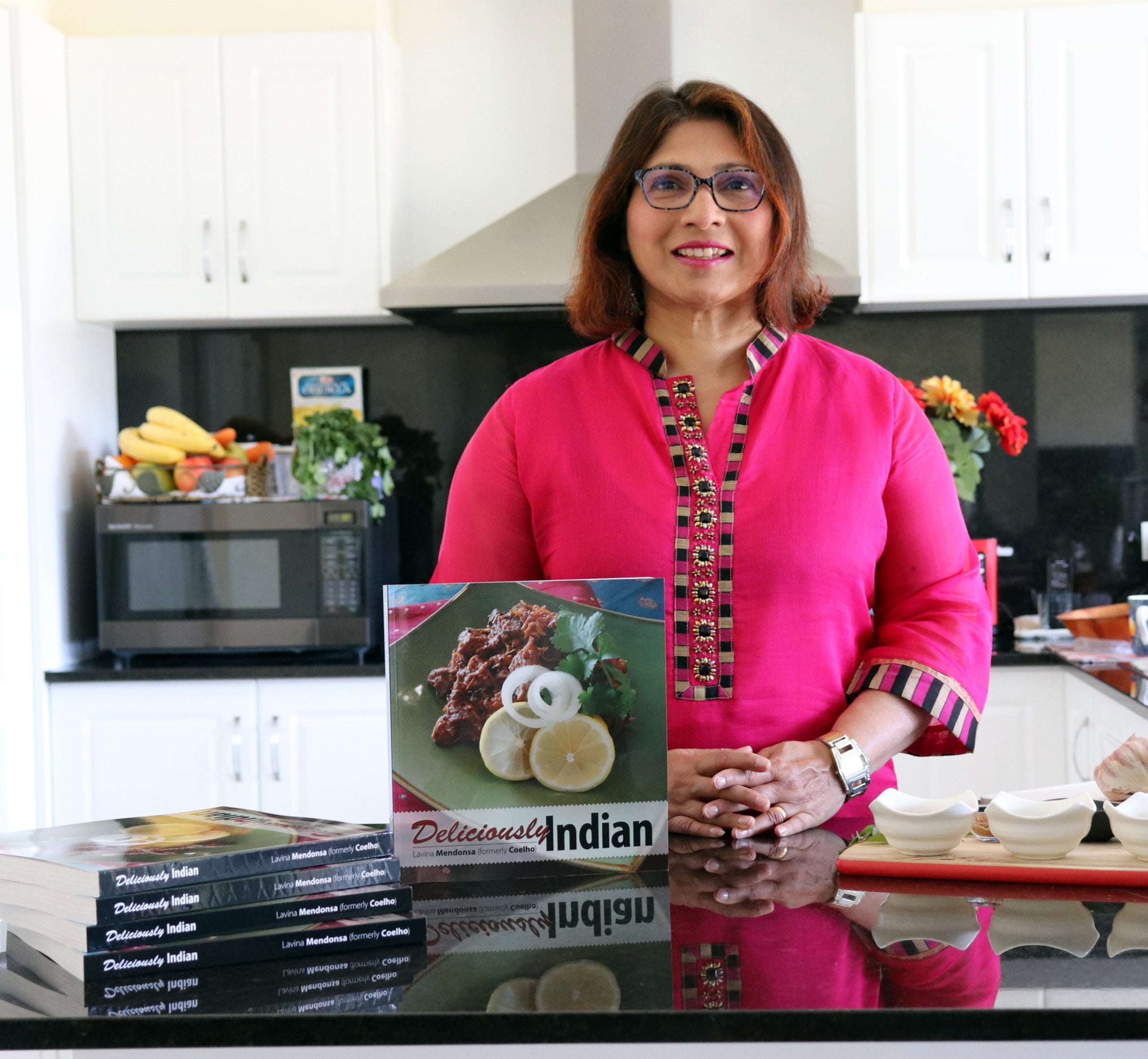

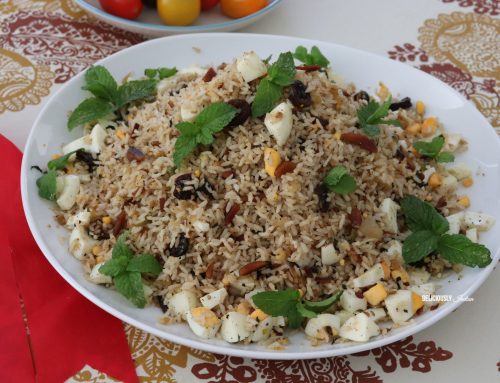
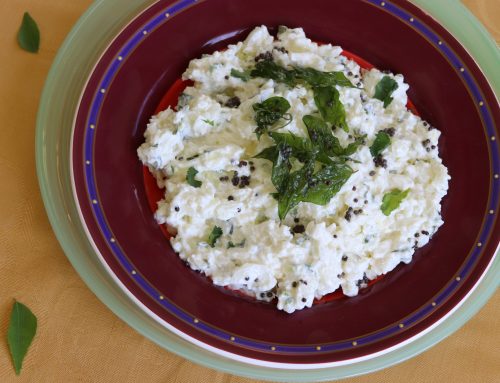
A great recipe which is very easy to make and for a sweet dish it is very healthy too. Love making this dish.
Hi Rekha
Thank you so much for trying out my Turmeric Leaves Patholi, your feedback and the star rating. Glad to hear that you found them easy to make and love making this dish. Happy New Year to you and your family!